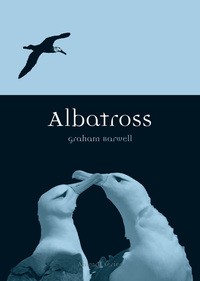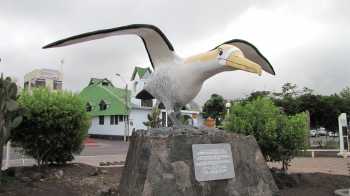Books on albatrosses come out regularly nowadays, with at least one title a year it seems. How does this latest offering - “Albatross” by Graham Barwell in Reaktion Books’ Animal Series stack up, say in comparison to “Albatrosses” (2008) by Terence Lindsay and a book of the same name (2011) by Tony Martin? Well, in a nutshell, this one is rather different.

The book (being published today so for once my review is not tardy) is described as “an engaging account of the historical relationship between people and albatross, and their impact on human cultures”; it “examines how people have interacted with the bird over the last two centuries, from those who sought to exploit them to those who devoted their lives to them.”
Following an introduction about albatrosses themselves the book has six chapters: “Encountering the Albatross; Imagining the Albatross; Using the Albatross: Indigenous Cultures of the Pacific; Using the Albatross: Non-indigenous Peoples; Saving the Albatross; and The Albatross Today: an Iconic Bird. There are also lists of selected references and websites (ACAP is the first listed) and an index.
Samuel Taylor Coleridge’s 1798 “The Rime of the Ancyent Mariner” gets covered in some detail of course, but you can also read what British privateer George Shelvocke of the Speedwell thought of albatrosses in 1719 when they shot “a disconsolate black Albitross” at sea in order to get a “fair wind after it’.
Less well known to me was the use of albatross feathers as “distinctive symbols of authority and status used in the highest ranks of Hawaiian society in the eighteenth and nineteenth centuries.” Why have I never visited the Bernice Pauahi Bishop Museum in Honolulu on my several Hawaiian visits to view the feather-bedecked “Red Awe of Heaven” made to celebrate the birth of a prince in 1858? Maybe next time… . I was also unaware that the Maori and Moriori of New Zealand used albatross feathers and down as head ornaments as well as to make cloaks.
The book then moves to more recent – and destructive – exploitation, notably of the North Pacific species for their eggs and feathers (for stuffing duvets and adorning hats), culminating in the near extinction of the Short-tailed Albatross Phoebastria albatrus. Cheerfully we can report that all three North Pacific albatrosses are now showing promising signs of recovery, although still considered threatened, as reported regularly in ACAP Latest News.

Waved Albatross in art
This photograph by John Cooper appears in Graham Barwell's "Albatross"
An error or two has crept into the more biological aspects of the book. For example, there have never been feral cats on Gough Island so the grave harm that the introduced House Mouse (click here!) continues to wreak on the island’s birds, most especially its near-endemic and Critically Endangered Tristan Albatross Diomedea dabbenena, is not due the removal of cats.
The author is an Associate Professor in the School of the Arts, English and Media at the University of Wollongong, in New South Wales, Australia. As befitting his position the book is well written and illustrated and is an easy read. I enjoyed going through it, polishing it off over just a few evenings, and pretty soon will want to read it again. I recommend it to albatross researchers and conservationists alike to round off their knowledge of these magnificent ocean flyers.
Lastly, pleasing to see ACAP Latest News gets used as one of the sources in the writing of this book!
References:
Barwell, Graham 2014. Albatross. London: Reaktion Books. Paperback. 101 illustrations, 51 in colour. 208 pp. ISBN 978 1 78023 191 4. GBP 9.99; AUD 24.00.
Martin, Tony 2011. Albatrosses. Grafton-on-Spey: Colin Baxter Photography. 72 pp.
Lindsey, Terence 2008. Albatrosses. Collingword: CSIRO Publishing. 139 pp.
John Cooper, ACAP Information Officer, 05 June 2014

 English
English  Français
Français  Español
Español